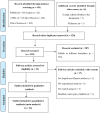Effect of Resistance Training Methods and Intensity on the Adolescent Swimmer's Performance: A Systematic Review
- PMID: 35444975
- PMCID: PMC9013834
- DOI: 10.3389/fpubh.2022.840490
Effect of Resistance Training Methods and Intensity on the Adolescent Swimmer's Performance: A Systematic Review
Abstract
Background: Resistance training has been widely used in various sports and improves competition performance, especially in swimming. Swimming performance is highly dependent on muscle strength, especially short distances. For adolescent athletes, the existing literature has bound to prove that resistance training is undoubtedly bound to improve swimmers' performance.
Objectives: This study adopts a systematic literature review to (1) examine the effects of resistance training on the performance of adolescent swimmers, and (2) summarize their training methods and intensity.
Methods: The literature search was undertaken in five international databases: the SCOUPS, PubMed, EBSCOhost (SPORTDiscus), CNKL, Web of Science. The searches covered documents in English and Chinese published until 30th December 2020. Electronic databases using various keywords related to "strength training" and "adolescent swimmers" were searched. Sixteen studies met the inclusion and exclusion criteria where the data was then systematically reviewed using the PRISMA guideline. Furthermore, the physical therapy evidence database (PEDro) scale was used to measure each study's scientific rigor.
Results: This review found that to improve the swimming performance of adolescents, two types of resistance training were used, specifically in water and on land, where both types of training can improve swimming performance. In addition, training with two types of resistance machines were better in the water than with one equipment. Resistance training can improve the swimming performance of adolescent swimmers at 50 m, 100 m, 200 m and 400 m distances. However, most studies only focused on the swimming performance at 50 m and 100 m lengths. A low-intensity, high-speed resistance training programme is recommended for adolescent swimmers to obtain the best training results.
Conclusion: Water or land resistance training can improve the swimming performance. Given that both types of exercises have their strengths and weaknesses, combining these methods may enhance the swimmers' performance. In addition, despite the starting and turning phases consuming up to one-third of the total swimming time for short distances, literature in this area is limited.
Systematic review registration: https://www.crd.york.ac.uk/prospero, identifier: CRD42021231510.
Keywords: combination; distance; physical activity; speed; strength.
Copyright © 2022 Guo, Soh, Zakaria, Hidayat Baharuldin and Gao.
Conflict of interest statement
The authors declare that the research was conducted in the absence of any commercial or financial relationships that could be construed as a potential conflict of interest.
Figures
Similar articles
-
A comprehensive review of training methods for physical demands in adolescent tennis players: a systematic review.Front Physiol. 2024 Sep 13;15:1449149. doi: 10.3389/fphys.2024.1449149. eCollection 2024. Front Physiol. 2024. PMID: 39345786 Free PMC article.
-
The methodology of resistance training is crucial for improving short-medium distance front crawl performance in competitive swimmers: a systematic review and meta-analysis.Front Physiol. 2024 Jul 26;15:1406518. doi: 10.3389/fphys.2024.1406518. eCollection 2024. Front Physiol. 2024. PMID: 39129754 Free PMC article.
-
Combined strength exercises on dry land and in the water to improve swimming parameters of athletes with paraplegia.J Sports Med Phys Fitness. 2018 Mar;58(3):197-203. doi: 10.23736/S0022-4707.16.06702-5. Epub 2016 Oct 11. J Sports Med Phys Fitness. 2018. PMID: 27727200
-
Effect of Different Types of Strength Training on Swimming Performance in Competitive Swimmers: A Systematic Review.Sports Med Open. 2022 Jan 31;8(1):19. doi: 10.1186/s40798-022-00410-5. Sports Med Open. 2022. PMID: 35099631 Free PMC article.
-
Monitoring weekly progress of front crawl swimmers using IMU-based performance evaluation goal metrics.Front Bioeng Biotechnol. 2022 Aug 8;10:910798. doi: 10.3389/fbioe.2022.910798. eCollection 2022. Front Bioeng Biotechnol. 2022. PMID: 36003533 Free PMC article.
Cited by
-
Assessing Aquatic Readiness as a Health-Enhancing Measure in Young Swimmers with Physical Disabilities: The Revised Aquatic Independence Measure (AIM-2).Int J Environ Res Public Health. 2025 Mar 13;22(3):421. doi: 10.3390/ijerph22030421. Int J Environ Res Public Health. 2025. PMID: 40238504 Free PMC article.
-
A comprehensive review of training methods for physical demands in adolescent tennis players: a systematic review.Front Physiol. 2024 Sep 13;15:1449149. doi: 10.3389/fphys.2024.1449149. eCollection 2024. Front Physiol. 2024. PMID: 39345786 Free PMC article.
-
Postural Control and Neuromuscular Activation in 11-13-Year-Old Athletic Boy Swimmers.Children (Basel). 2024 Jul 16;11(7):863. doi: 10.3390/children11070863. Children (Basel). 2024. PMID: 39062312 Free PMC article.
References
-
- Maglischo E, Maglischo C, Zier D, Santos D. The effects of sprint-assisted and sprint-resisted swimming on stroke mechanics. J Swim Res. (1985) 1:27–33.
-
- Morrison L, Peyrebrune M, Folland J. Resisted-swimming training improves 100 m freestyle performance in elite swimmers. J Sport Sci. (2005) 23:1149–303.
-
- Wakayoshi K, D'Acquisto J, Cappaert J, Troup JP. Relationship between metabolic parameters and stroking technique characteristics in front crawl. In: Troup JP, Hollander AP, Strasse D, Trappe SW, Cappaert JM, Trappe TA. editors. Biomechanics and medicine in swimming VII. London: Taylor & Francis. (1996). p. 152–8.
Publication types
MeSH terms
Substances
LinkOut - more resources
Full Text Sources
Miscellaneous


